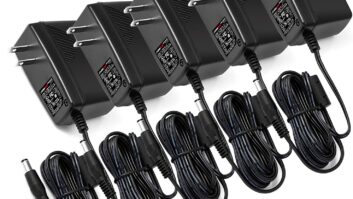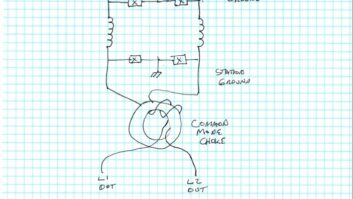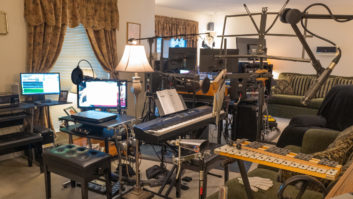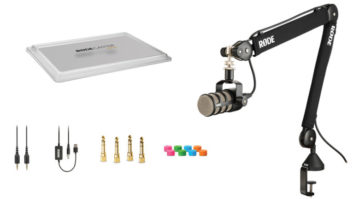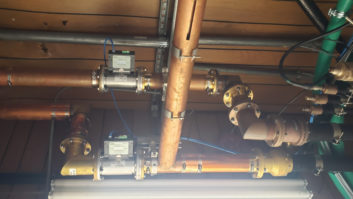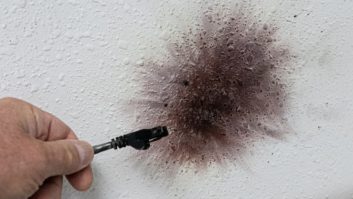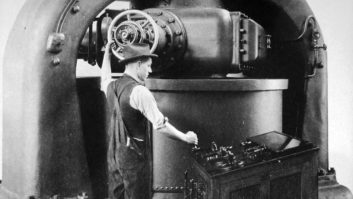There are numerous FM antenna designs commercially available with various characteristics. Types include the panel with crossed dipole, ring, ring-stub, slanted dipole and “rototiller.”
In the early days of FM broadcasting, several variations of the ring radiator were designed for both horizontal and vertical polarization. It was found that by adding vertical stubs to the ends of the radiator, one could produce elliptical polarization. It is difficult to produce true circular polarization with a ring or ring stub radiator because the axial ratio varies with azimuth. Over the years, the design has been improved by adding a second ring. One advantage of this type of radiator is its excellent circularity in free space. A disadvantage is that it is a high-Q design and is more susceptible to detuning because of icing.
A variation on the ring radiator is the ring-stub. The horizontally-polarized radiation is produced by the ring portion of the radiating element. The popular Shively 6814 is an example of a ring-stub design.
Slants and panels
The slanted dipole antenna was developed in the 1970s. As its name implies, it consists of two half-wavelength slanted dipoles bent 90 degrees. The two dipoles are fed in phase. The ratio of V-pol and H-pol radiated power is determined by the slant angle. Shunt feeding provides for equal currents in all four dipole arms, which produces excellent circularity. The Jampro Penetrator is an example of a slanted dipole antenna.
Another popular design, often called the “rototiller” because the radiating elements have a shape similar to that of the blades of a rototiller, consists of two series-fed bent dipole elements, forming a space-phased, circularly polarized radiator. This configuration in combination with the relatively large diameter of the radiating elements tends to produce good bandwidth and inhibit corona discharge. The ERI SHPX is an example of this type of antenna.
Panel antennas were developed in the 1950s specifically for collocated stations. They come in flat and cavity-backed configurations. Both the flat frame and cavity are made of a large-diameter wire mesh with 4- to 12-inch openings. The mesh appears electrically as a solid surface but produces little wind loading.
Two crossed dipoles are used as the illuminating source for each panel or cavity. The dipoles are fed 90 degrees out of phase to produce circular polarization. This type of antenna typically is side-mounted on a large-aperture tower.
Because they are directional, panel antennas usually require three or four panels, mounted around the tower to produce a circular horizontal radiation pattern; circularity on the order of 2 dB is achievable. The cavity-backed design offers better axial ratios with more controllable azimuth pattern and better bandwidth. Cavity-backed panel antennas provide a lot of control where directivity is important.
With all these designs, antenna gain is achieved by vertically stacking multiple antenna elements or “bays” at full- or half-wavelength spacing on a common feed. A single circularly-polarized bay operating by itself usually exhibits a negative gain over a half-wave dipole in free space, while two bays usually provide near-unity gain. More than two bays will exhibit a positive gain, and gains of up to seven are possible with an antenna with 12 bays.
A good match
Matching is an important consideration in FM antenna arrays.
The simplest and perhaps most common method uses a VSWR tuner. This matching section is inserted between the transmission line and the antenna interbay line and consists of variable capacitors at 1/8-wavelength spacing along the main feeder at the antenna input.
This type of matching section is used on many side-mounted antennas. It is adjusted for minimum reflected power to the transmitter. The net effect of this matching scheme is to place an impedance in parallel with the antenna impedance to match it to the 50-ohm line. The disadvantages of this method are that it is bandwidth-limited and it produces standing waves within the interbay line.
Another matching scheme involves the use of dielectric or metal slugs on the main transmission line inner conductor. This type of matching scheme produces better bandwidth, although it is more difficult to adjust.
Other, more complex schemes use phase quadrature compensation to achieve extremely wide bandwidth. This type of matching scheme more typically is used on master antennas fed by multiple collocated stations.
Deicing equipment, either in the form of electric heat or radomes, tends to increase the complexity, cost, required maintenance and weight of an antenna. When ice forms on an antenna, the resonant frequency of the antenna tends to go down. A narrowband antenna with even a small amount of ice will present an unacceptably high VSWR to the transmitter, possibly leading to damage not only to the transmitter but also to the transmission line and the antenna itself.
Deicing equipment keeps ice from forming on the radiating elements, thus preventing this detuning. Broadband antennas, while detuned by ice just as more narrowband designs are, have sufficient bandwidth that the detuning has little effect on the load presented to the transmitter.
Keep in mind that high initial cost may be offset by many years of low maintenance costs. The converse also is true. When selecting an antenna, the best approach is to select the best antenna that your budget can stand. After all, what other part of your transmission system has more effect on the signal you present to your audience?
In the next installment, we will look at transmission lines.





